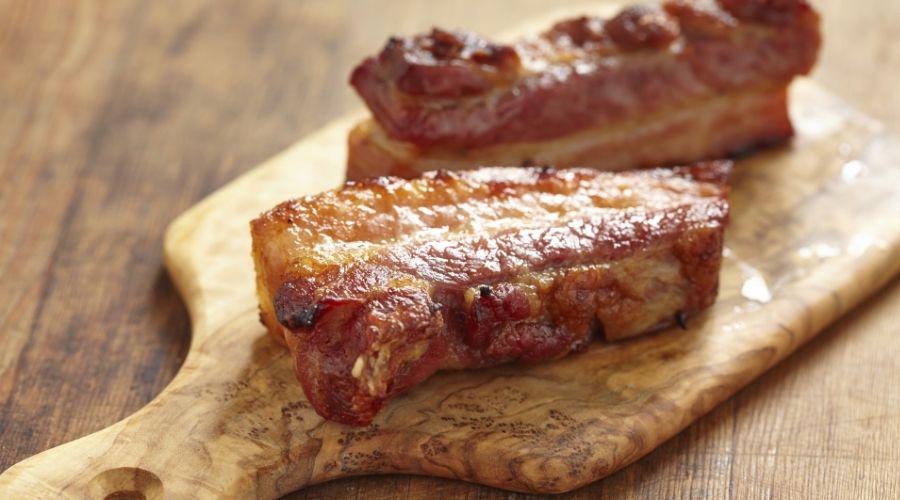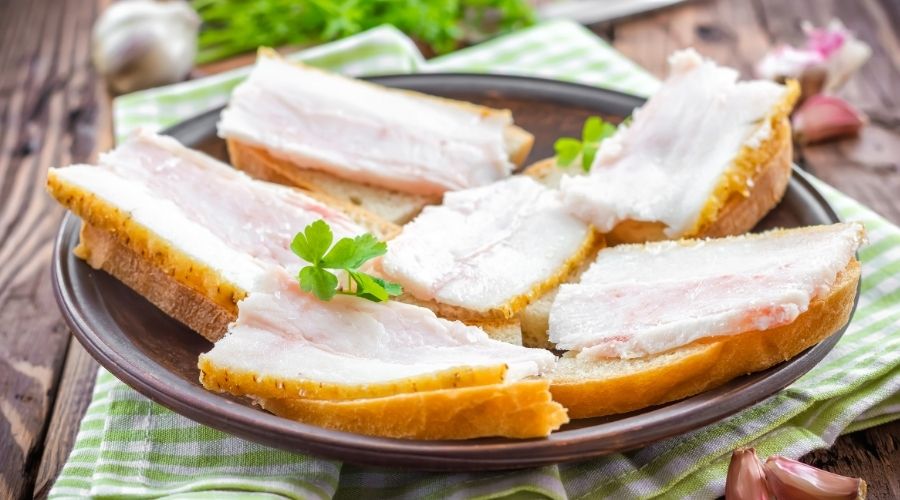Storing cooked fatback properly is essential for preserving its rich flavor and texture while ensuring food safety.
This traditional ingredient, often used to enhance dishes with its savory taste, can easily spoil if not handled correctly.
Whether you’re preparing a batch for a hearty meal or storing leftovers, knowing how to store cooked fatback will help you enjoy its deliciousness for days to come.
In this article, we’ll explore the best practices for storing cooked fatback, including tips on cooling, container selection, and more.
Why Storing Cooked Fatback Properly Matters
Storing cooked fatback properly is crucial for both food safety and maintaining flavor. Fatback, which is the layer of fat from the back of a pig, is rich in flavor and can enhance a variety of dishes.
However, like any cooked meat product, it is susceptible to spoilage if not stored correctly.
Proper storage helps to prevent bacterial growth, ensuring that the fatback remains safe to eat.
Additionally, correct storage methods, such as refrigeration or freezing, can preserve its rich taste and texture, making it a delightful addition to meals long after it’s cooked.
When stored improperly, cooked fatback can develop off-flavors, lose its desirable texture, and ultimately become unsafe for consumption.
By following the right storage techniques, you can enjoy this flavorful ingredient at its best while minimizing waste.
How to Store Cooked Fatback: A Complete Guide

Storing cooked fatback properly ensures that this flavorful ingredient retains its quality and remains safe to eat.
Here’s a comprehensive guide to help you store cooked fatback effectively.
1. Cooling Before Storage
Before storing cooked fatback, allow it to cool to room temperature. This step is essential to prevent condensation from forming inside the storage container, which can lead to spoilage.
2. Choose the Right Storage Container
Use airtight containers or heavy-duty resealable plastic bags to store cooked fatback.
Glass containers are a great choice for visibility and preventing odors from absorbing, while plastic bags are ideal for saving space in the fridge or freezer.
3. Portioning for Convenience
If you’ve cooked a large batch, consider portioning the fatback into smaller amounts before storing. This makes it easier to defrost and use only what you need for future meals, reducing waste.
4. Refrigeration
For short-term storage, refrigerate the cooked fatback. It should be consumed within 3-5 days when stored in the fridge.
Make sure the container is tightly sealed to prevent air exposure, which can lead to drying out or absorbing other odors.
5. Freezing for Long-Term Storage
If you want to store cooked fatback for an extended period, freezing is the best option. Fatback can be frozen for up to 3 months without significantly losing quality.
Ensure it’s wrapped tightly in plastic wrap or placed in a freezer-safe bag, removing as much air as possible before sealing.
6. Thawing Cooked Fatback
When you’re ready to use frozen fatback, thaw it safely in the refrigerator overnight or using the defrost setting on your microwave. Avoid thawing at room temperature, as this can promote bacterial growth.
7. Reheating Techniques
To reheat cooked fatback, use a skillet over low to medium heat, or place it in the oven until warmed through.
This method helps maintain its rich flavor and texture, making it an excellent addition to your dishes.
8. Check for Spoilage
Before consuming stored fatback, always check for signs of spoilage. Look for any off odors, discoloration, or unusual textures.
If you notice anything suspicious, it’s best to discard the fatback to ensure food safety.
By following these guidelines, you can effectively store cooked fatback, ensuring it remains delicious and safe to enjoy in your meals.
What to Look for While Storing Cooked Fatback

When storing cooked fatback, it’s essential to consider several factors to ensure its freshness and safety.
Here’s what to keep in mind:
1. Temperature Control
Ensure that cooked fatback is cooled and stored at the right temperature. Ideally, it should be refrigerated at or below 40°F (4°C) within two hours of cooking to prevent bacterial growth. If you plan to freeze it, make sure your freezer is set to 0°F (-18°C) or lower.
2. Container Quality
Choose high-quality, airtight containers or heavy-duty resealable bags for storage.
Containers should be durable and designed to prevent air exposure, which can lead to spoilage and freezer burn.
Glass containers are a great option, as they don’t retain odors and are easy to clean.
3. Portion Sizes
Consider portioning the fatback before storing it. This not only makes it easier to defrost and reheat but also minimizes waste by allowing you to use only what you need.
Smaller portions are more manageable and help maintain quality.
4. Labeling
Always label your storage containers or bags with the date of cooking. This practice helps you keep track of how long the fatback has been stored, ensuring you use it within the recommended time frame (3-5 days in the fridge, up to 3 months in the freezer).
5. Observing for Spoilage
Before storing, inspect the cooked fatback for any signs of spoilage. Look for off odors, discoloration, or any unusual textures. If any of these signs are present, it’s best to avoid storing it and discard it instead.
6. Avoid Cross-Contamination
When handling cooked fatback, ensure that your hands, utensils, and surfaces are clean to avoid cross-contamination with raw foods or other cooked items. This step is crucial for maintaining food safety.
By paying attention to these factors, you can ensure that your cooked fatback remains safe to eat and retains its delicious flavor, enhancing your meals for days to come.
How to Choose the Right Accessories for Storing Cooked Fatback
Selecting the right accessories for storing cooked fatback is vital for maintaining its quality and ensuring food safety.
Here’s how to choose the best storage options:
1. Airtight Containers
Opt for airtight containers made of glass or BPA-free plastic. These containers prevent air from entering, which can lead to spoilage and drying out.
Glass containers are particularly beneficial as they don’t absorb odors and can go from the fridge to the microwave or oven.
2. Resealable Plastic Bags
Heavy-duty resealable plastic bags are an excellent alternative for short-term storage or freezing.
They are space-efficient and allow you to remove excess air, which is key to preventing freezer burn.
Look for bags that are labeled as freezer-safe to ensure they withstand low temperatures.
3. Vacuum Sealers
For optimal freshness, consider using a vacuum sealer. This device removes air from storage bags, creating a tight seal that greatly extends the shelf life of cooked fatback, especially in the freezer.
Vacuum-sealed fatback can last much longer without compromising quality.
4. Labels and Markers
Invest in labels or use masking tape and a permanent marker to label your storage containers and bags.
Clearly mark the date of cooking and the contents. This practice helps you keep track of storage times and ensures you use the fatback before it spoils.
5. Parchment Paper or Wax Paper
If you plan to stack multiple pieces of cooked fatback, consider using parchment or wax paper between layers.
This prevents them from sticking together, making it easier to separate portions when you’re ready to use them.
6. Freezer-Safe Accessories
When freezing cooked fatback, ensure that your chosen accessories are labeled as freezer-safe.
This ensures they can withstand the cold without cracking or breaking, which could lead to contamination or freezer burn.
7. Temperature Monitoring Tools
If you frequently store cooked fatback and other perishables, consider investing in a refrigerator thermometer.
This tool helps you monitor the temperature inside your fridge to ensure it stays at safe levels, thereby maintaining the quality of your stored food.
By selecting the right storage accessories, you can effectively preserve the flavor and safety of your cooked fatback, making it a versatile ingredient for your meals.
How to Tell If Cooked Fatback Is Bad After Storing
Determining whether cooked fatback has gone bad is essential for ensuring food safety and avoiding foodborne illness.
Here are key indicators to look for:
1. Visual Inspection
Start by examining the fatback for any visible signs of spoilage. Look for mold, which can appear as fuzzy spots in various colors (green, blue, or white).
If you see any mold, it’s best to discard the entire batch, as mold can spread beyond what is visible.
2. Off Odors
Trust your sense of smell. Freshly cooked fatback has a rich, savory aroma. If you detect any sour, rancid, or unusual smells, this is a strong indication that the fatback has spoiled.
Do not taste it if it smells off.
3. Texture Changes
Check the texture of the fatback. Fresh cooked fatback should be firm and slightly greasy.
If it feels excessively slimy or has developed a sticky texture, these are signs of bacterial growth, and it should be discarded.
4. Color Changes
Observe any changes in color. Cooked fatback typically has a pale to golden hue. If you notice significant darkening or grayish discoloration, it may be a sign of spoilage.
While some color change can occur naturally over time, drastic changes should raise a red flag.
5. Date Check
Always refer to the date you labeled on your storage container. If the fatback has been stored longer than the recommended time—3-5 days in the refrigerator or 2-3 months in the freezer—it’s safest to throw it away, even if there are no obvious signs of spoilage.
6. Freezer Burn
If the fatback has been frozen, look for signs of freezer burn, which can appear as dry, grayish patches on the surface.
While freezer-burned fatback may not be harmful to eat, its quality may be compromised, affecting the flavor and texture.
By keeping an eye out for these signs, you can ensure that your stored cooked fatback remains safe and enjoyable to eat.
When in doubt, it’s always better to err on the side of caution and discard any questionable items.
1. How long can cooked fatback be stored in the refrigerator?
Cooked fatback can be stored in the refrigerator for 3 to 5 days. Ensure it is kept in an airtight container to maintain freshness.
2. Can cooked fatback be frozen?
Yes, cooked fatback can be frozen for up to 3 months. Use freezer-safe bags or airtight containers to prevent freezer burn and preserve quality.
3. What is the best way to cool cooked fatback before storage?
Allow the cooked fatback to cool at room temperature for about 30 minutes before transferring it to the refrigerator or freezer. This helps prevent condensation in the storage container.
4. How should cooked fatback be reheated?
To reheat cooked fatback, place it in a skillet over low to medium heat, or warm it in the oven until heated through. Avoid microwaving, as it can make the texture rubbery.
5. How can I tell if stored cooked fatback has gone bad?
Check for signs of spoilage such as off odors, slimy texture, mold, or significant color changes. If you notice any of these, it’s best to discard it.
6. Is it safe to leave cooked fatback out at room temperature?
Cooked fatback should not be left out at room temperature for more than 2 hours. Bacteria can grow rapidly in the “danger zone” between 40°F and 140°F (4°C and 60°C).
7. Can I store cooked fatback in plastic wrap?
While plastic wrap can be used, it’s better to use airtight containers or heavy-duty resealable bags for optimal freshness and to prevent air exposure, which can lead to spoilage.
Conclusion
In conclusion, storing cooked fatback correctly not only helps maintain its quality but also ensures that it remains safe to eat.
By following the guidelines outlined in this article, you can enjoy your cooked fatback without the worry of spoilage.
Remember to monitor storage times, use appropriate containers, and check for any signs of spoilage before use.
With these practices in place, you can make the most of this flavorful ingredient in your culinary creations.
References
- https://www.youtube.com/watch?v=dQw4w9WgXcQ&t=2s&ab_channel=RickAstley
- https://www.quora.com/How-do-you-properly-and-safely-store-fat-grease-from-meats-you-cook-for-later-use
- https://www.reddit.com/r/Charcuterie/comments/7zhb0h/fatback_left_in_vac_bag_at_room_temperature/
- https://www.southernliving.com/what-is-fatback-7090538
- https://eatcuredmeat.com/dry-curing/does-salt-pork-go-bad/


